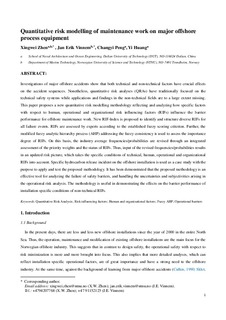| dc.contributor.author | Zhen, Xingwei | |
| dc.contributor.author | Vinnem, Jan Erik | |
| dc.contributor.author | Peng, Changyi | |
| dc.contributor.author | Huang, Yi | |
| dc.date.accessioned | 2019-02-25T08:13:05Z | |
| dc.date.available | 2019-02-25T08:13:05Z | |
| dc.date.created | 2018-11-26T20:11:46Z | |
| dc.date.issued | 2018 | |
| dc.identifier.citation | Journal of Loss Prevention in the Process Industries. 2018, 56 430-443. | nb_NO |
| dc.identifier.issn | 0950-4230 | |
| dc.identifier.uri | http://hdl.handle.net/11250/2587114 | |
| dc.description.abstract | Investigations of major offshore accidents show that both technical and non-technical factors have crucial effects on the accident sequences. Nonetheless, quantitative risk analyses (QRAs) have traditionally focused on the technical safety systems while applications and findings in the non-technical fields are to a large extent missing. This paper proposes a new quantitative risk modelling methodology reflecting and analyzing how specific factors with respect to human, operational and organizational risk influencing factors (RIFs) influence the barrier performance for offshore maintenance work. New RIF-Index is proposed to identify and structure diverse RIFs for all failure events. RIFs are assessed by experts according to the established fuzzy scoring criterion. Further, the modified fuzzy analytic hierarchy process (AHP) addressing the fuzzy consistency is used to assess the importance degree of RIFs. On this basis, the industry average frequencies/probabilities are revised through an integrated assessment of the priority weights and the status of RIFs. Thus, input of the revised frequencies/probabilities results in an updated risk picture, which takes the specific conditions of technical, human, operational and organizational RIFs into account. Specific hydrocarbon release incident on the offshore installation is used as a case study with the purpose to apply and test the proposed methodology. It has been demonstrated that the proposed methodology is an effective tool for analyzing the failure of safety barriers, and handling the uncertainties and subjectivities arising in the operational risk analysis. The methodology is useful in demonstrating the effects on the barrier performance of installation specific conditions of non-technical RIFs. | nb_NO |
| dc.language.iso | eng | nb_NO |
| dc.publisher | Elsevier | nb_NO |
| dc.rights | Attribution-NonCommercial-NoDerivatives 4.0 Internasjonal | * |
| dc.rights.uri | http://creativecommons.org/licenses/by-nc-nd/4.0/deed.no | * |
| dc.title | Quantitative risk modelling of maintenance work on major offshore process equipment | nb_NO |
| dc.type | Journal article | nb_NO |
| dc.type | Peer reviewed | nb_NO |
| dc.description.version | acceptedVersion | nb_NO |
| dc.source.pagenumber | 430-443 | nb_NO |
| dc.source.volume | 56 | nb_NO |
| dc.source.journal | Journal of Loss Prevention in the Process Industries | nb_NO |
| dc.identifier.doi | 10.1016/j.jlp.2018.10.004 | |
| dc.identifier.cristin | 1635390 | |
| dc.description.localcode | © 2018. This is the authors’ accepted and refereed manuscript to the article. Locked until 11.10.2020 due to copyright restrictions. This manuscript version is made available under the CC-BY-NC-ND 4.0 license http://creativecommons.org/licenses/by-nc-nd/4.0/ | nb_NO |
| cristin.unitcode | 194,64,20,0 | |
| cristin.unitname | Institutt for marin teknikk | |
| cristin.ispublished | true | |
| cristin.fulltext | postprint | |
| cristin.qualitycode | 1 | |

